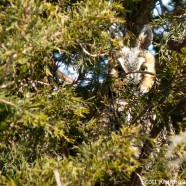Four-spotted Agonopterix
This appears to be the Four-spotted Agonopterix (Agonopterix robiniella) moth. In this case I spotted it on the ground while walking my dog on a cloudy afternoon. I have no idea where you should be looking for life because anywhere you stare at this time of year leads you to something special! Scott Kruitbosch Conservation & Outreach Coordinator
Read MoreLesser Maple Spanworm
I had literally one shot of this moth, and here it is! I suppose the camera and the flash at dusk was enough for it to think about finding a better spot as it flew off to another bush. It looks to be a Lesser Maple Spanworm (Speranza pustularia), a common species with its name as a host plant, among several other abundant trees. Scott Kruitbosch Conservation & Outreach Coordinator
Read MoreSpring Sunset
The sun is setting on the spring soon as the longest days of the year are here. We hope you get outdoors to enjoy all of the light and life surrounding us in our Wild America this weekend. Have a wonderful time!
Read MoreDiurnal Barred Owl
Recently I heard a Barred Owl calling during the mid-afternoon on a warm, beautiful day. It did not take but a few minutes for an even closer bird to start asking, “Who cooks for you?” in response. They were relatively close to me but out of sight in neighboring yards. This photo is from a past sighting of a diurnal Barred Owl during the early spring when the leaves were already popping. Keep an ear open for these nocturnal neighbors all day and night! Scott Kruitbosch Conservation & Outreach Coordinator
Read MoreLong-eared Owl (Asio otus)
Here’s an old photo from one of my point and shoot cameras, zoomed in quite far about 30 times and further cropped, of a Long-eared Owl (Asio otus) roosting in a tree. Taking such a photo during the daylight hours, in the bright winter sun, of such a sensitive bird species should only be done from far away. You do not want to risk disturbing or flushing them from their location as Long-eared Owls are especially sensitive to human intrusion. They will be alarmed easily and fly from the location, exposing them to attacks from other predators and mobbing by songbirds. They will also often...
Read More








